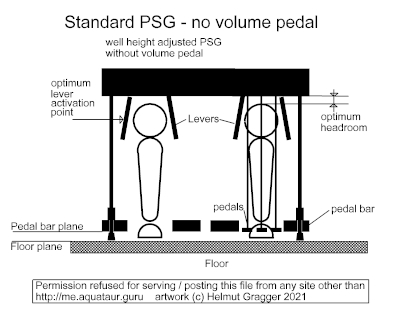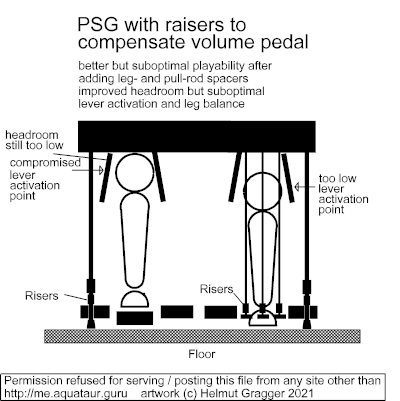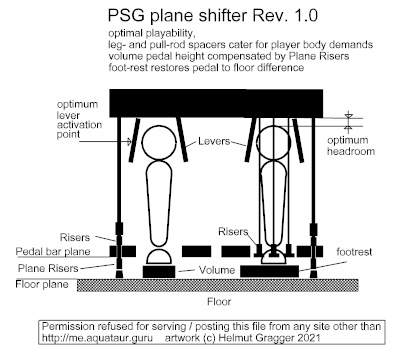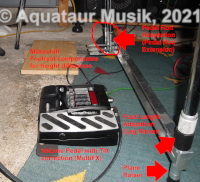| Making The Pedal Steel
Guitar Fit (For) A Volume Pedal Donīt Compromise For Playability last update: June 22, 2021 Copyright
2021-25 by H. Gragger. All Rights Reserved. All
information provided herein is destined for
educational and D.I.Y. purposes only. Commercial
re-sale, distribution or usage of artwork
without explicit written permission of the
author is strictly prohibited. The original
units with their associated
trade-names are subject to the copyright of the
individual copyright owner. The Author is by no
means affiliated with any of those companies.
References to trade names are made for
educational purposes only. By reading the
information provided here you agree to the Terms
of
Use. The working language
is kept in English as an aid. Read here
why.
|
|||||||||||||
| MAIN PAGE>MUSIC STUFF>STEEL_PLANE_SHIFTER Index   Introduction My recently acquired pedal steel guitar (from hereon: PSG) was set up with a copedent suiting the needs of the previous owner. I adapted all this to my needs, and alongside I installed a raiser kit to accommodate my leg size. All worked well - until I put my volume pedal beneath. Read on how I solved this elegantly...
Or in less technical terms for the mere mortal:
Obviously, the PSG was not originally designed to account for a bulky object like a volume pedal, and equally obvious, that issue has never been responded to on a broad scale, as little as an on-the-fly height adaptation without having to insert a raiser kit. This is a ball and chain, and people live with it, thinking there is no cure. But wait... Back To Index I cursed the damned volume pedal that had blown all my beautiful setup sky high and wished it would disappear into a crevasse in the ground - stop! Thatīs it! So the first thought that came to mind was that, with the guitar set up properly, the volume pedal should disappear into a cavity in the floor plane under the guitar more or less flush. An intuitive approach would be making a pedestal that rises the floor inclusive guitar and chair, with a cutout for the volume pedal, so that the pedal disappears flush. Hmm, working but cumbersome. But it so happens that the chairīs spindle (for at least the drum throne I use) is length adjustable, so are the steelīs legs. Perfect. This enables us to make the volume pedal relatively lower by raising the rest. At this point I have to mention, that it is beyond my comprehension how people can put up with the otherwise very appealing dedicated steel guitar chairs, when they are not variable in height. Are all people made equal? You have to raise your guitar but sit too low?
The practical solution then is:
Back To Index Setting Volume Pedal Equilibrium Point It turns out
that the expression pedal on the MultiFX-device I
use (technically a perfect volume pedal) is
clearly designed for a person operating it from a
position standing right behind the unit. The
pedalīs equilibrium point (full toe
position) thus maintains a certain angle towards
ground, which makes sense because the lower leg
meets the pedal at this very angle. But not for a
seated player where the lower leg meets the pedal
perpendicularly, such as under a PSG. This changes
the useful pedal sweep and feeling substantially. You get away with it well for a lap-steel guitar, because you have leeway towards the front. But you are limited on a PSG.Again, the remedy is easy. A small spacer corrects the tilt to taste. I like it best when the full toe down position points a hair downwards, but I encourage you to play with that to find your own sweet spot. This also depends on the taper of the volume pedal.
I also
noticed, that when engaging the RKL lever I exert
a sideways force onto the pedal it would not
encounter under its destined purpose of usage,
which gives it a tendency to make it tipping to
the right. To counter this, I functionally
broadened its base plate by extending the spacer
plate to the right side. Done. You see, those
changes can be done optically unobtrusive
and quickly undoable. The spacer plate can be
attached with velcro or double-sided tape. Reference [1] I generally advise against using vintage pedals. See here and here [2] Some HDPE water pipe will do fine, this is what I had and used. [3] Steel Guitar Forum: Volume Pedal - Choosing Between Standard and Low Profile, https://bb.steelguitarforum.com/viewtopic.php?t=215070 Back To Index Update History
MAIN PAGE>MUSIC STUFF>STEEL_PLANE_SHIFTER |
|||||||||||||
MAIN PAGE | MUSIC STUFF | IMPRESSUM  (c) 2021-25 AQUATAUR Musik & Elektronik |




